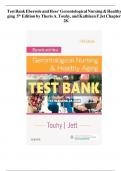Test Bank Ebersole and Hess’ Gerontological Nursing & Healthy
5 5 5 5 5 5 5 5
ging 5th Edition by Theris A. Touhy, and Kathleen F Jet Chapter
5
5
5 5 5 5 5 5 5 5 5
28.
,Chapter501:5Introduction5to5Healthy5Aging
Touhy5&5Jett:5Ebersole5and5Hess’5Gerontological5Nursing5&5Healthy5Aging,55th5Editio
n
MULTIPLE5CHOICE
1. A5man5is5terminally5ill5with5end-
stage5prostate5cancer.5Which5is5the5best5statement5about5this5man’s5wellness?
a. Wellness5can5only5be5achieved5with5aggressive5medical5interventions.
b. Wellness5is5not5a5real5option5for5this5client5because5he5is5terminally5ill.
c. Wellness5is5defined5as5the5absence5of5disease.
d. Nursing5interventions5can5help5empower5a5client5to5achieve5a5higher5level5of
5wellness.
ANS:5 D
Nursing5interventions5can5help5empower5a5client5to5achieve5a5higher5level5of5wellness;5a5nurse5
can5foster5wellness5in5his5or5her5clients.5Wellness5is5defined5by5the5individual5and5is5multidim
ensional.5It5is5not5just5the5absence5of5disease.5A5wellness5perspective5is5based5on5the5belief5tha
t5every5person5has5an5optimal5level5of5health5independent5of5his5or5her5situation5or5functional5l
evel.5Even5in5the5presence5of5chronic5illness5or5while5dying,5a5movement5toward5wellness5is5p
ossible5if5emphasis5of5care5is5placed5on5the5promotion5of5well-
being5in5a5supportive5environment.
PTS:5 1 DIF: Apply REF:5 p.57
TOP:5 Nursing5Process:5Diagnosis5MSC:5 Health5Promotion5and5Maintenance
N R I G B.C M
2. In5differentiating5between5healU
th aS
nd wNellnTess in hOealth5care,5which5of5the5following
5statements5is5true?
a. Health5is5a5broad5term5encompassing5attitudes5and5behaviors.
b. The5concept5of5illness5prevention5was5never5considered5by5previous5generations.
c. Wellness5and5self-actualization5develop5through5learning5and5growth.
d. Wellness5is5impossible5when5one’s5health5is5compromised.
ANS:5 A
Health5is5a5broad5term5that5encompasses5attitudes5and5behaviors;5holistically,5health5includes5
wellness,5which5involves5one’s5whole5being.5The5concept5of5illness5prevention5was5never5con
sidered5by5previous5generations;5throughout5history,5basic5self-
care5requirements5have5been5recognized.5Wellness5and5self-
actualization5develop5through5learning5and5growth—
as5basic5needs5are5met,5higher5level5needs5can5be5satisfied5in5turn,5with5ever-
deepening5richness5to5life.5Wellness5is5possible5when5one’s5health5is5compromised—
even5with5chronic5illness,5with5multiple5disabilities,5or5in5dying,5movement5toward5a5higher5le
vel5of5wellness5is5possible.
PTS:5 1 DIF: Understand REF:5 p.57
TOP:5 Nursing5Process:5Evaluation5MSC:5 Health5Promotion5and5Maintenance
3. Which5racial5or5ethnic5group5has5the5highest5life5expectancy5in5the5United5States?
a. Native5Americans
b. African5Americans
c. Hispanic5Americans
d. Asian5and5Pacific5Island5Americans
NURSINGTB.COM
, Ebersole5and5Hess'5Gerontological5Nursing5and5Healthy5Aging55th5Edition5Touhy5Test5Bank
Chapter502:5Cross-Cultural5Caring5and5Aging
Touhy5&5Jett:5Ebersole5and5Hess’5Gerontological5Nursing5&5Healthy5Aging,55th5Editio
n
MULTIPLE5CHOICE
1. Which5of5the5following5is5a5true5statement5about5differing5health5belief5systems?
a. Personalistic5or5magicoreligious5beliefs5have5been5superseded5in5Western5minds5by
5biomedical5principles.
b. In5most5cultures,5older5adults5are5likely5to5treat5themselves5using5traditional
5methods5before5turning5to5biomedical5professionals.
c. Ayurvedic5medicine5is5another5name5for5traditional5Chinese5medicine.
d. The5belief5that5health5depends5on5maintaining5a5balance5among5opposite5qualities
5is5characteristic5of5a5magicoreligious5belief5system.
ANS:5 B
Older5adults5in5most5cultures5usually5have5had5experience5with5traditional5methods5that5have5
worked5as5well5as5expected.5After5these5treatments5fail,5older5adults5turn5to5the5formal5health5
care5system.5Even5in5the5United5States,5it5is5common5for5older5adults5to5pray5for5cures5or5won
der5what5they5did5to5incur5an5illness5as5punishment.5The5Ayurvedic5system5is5a5naturalistic5h
ealth5belief5system5practiced5in5India5and5in5some5neighboring5countries.5This5belief5is5chara
cteristic5of5a5holistic5or5naturalistic5approach.
PTS:5 5 1 DIF: Understand REF:5 5 p.516-17
TOP:5 Nursing5Process:5Assessment MSC:5 Health5Promotion5and5Maintenance
N R I G B .C M
2. Which5of5the5following5consideUratiS
onsNis m
Tost likO
ely5to5be5true5when5working5with5an
5interpreter?
a. An5interpreter5is5never5needed5if5the5nurse5speaks5the5same5language5as5the5patient.
b. When5working5with5interpreters,5the5nurse5can5use5technical5terms5or5metaphors.
c. A5patient’s5young5granddaughter5who5speaks5fluent5English5would5make5the5best
5interpreter5because5she5is5familiar5with5and5loves5the5patient.
d. The5nurse5should5face5the5patient5rather5than5the5interpreter.
ANS:5 D
The5nurse5should5face5the5patient5rather5than5the5interpreter5is5a5true5statement;5the5intent5is5to
5converse5with5the5patient,5not5with5a5third5party5about5the5patient.5Many5reasons5may5prevent
5the5patient5from5speaking5directly5to5a5nurse.5Technical5terms5and5metaphors5may5be5difficul
t5or5impossible5to5translate.5Cultural5restrictions5may5prevent5some5topics5from5being5spoken5
of5to5a5grandparent5or5child.
PTS:5 5 1 DIF:5 5 Understand5 5 REF:5 5 p.518-19
TOP:5 Nursing5Process:5Implementation5 5 MSC:5 Safe,5Effective5Care5Environment
3. An5older5adult5who5is5a5traditional5Chinese5man5has5a5blood5pressure5of580/545mm5Hg5and5ref
uses5to5remain5in5the5bed.5Which5intervention5should5the5nurse5use5to5promote5and5maintain5hi
s5health?
a. Have5the5health5care5provider5speak5to5him.
b. Use5principles5of5the5holistic5health5system.
c. Ask5about5his5perceptions5and5treatment5ideas.
NURSINGTB.COM
, Ebersole5and5Hess'5Gerontological5Nursing5and5Healthy5Aging55th5Edition5Touhy5Test5Bank
d. Consult5with5a5practitioner5of5Chinese5medicine.
ANS:5 C
Using5the5LEARN5model5(listen5with5sympathy5to5the5patient’s5perception5of5the5problem,5ex
plain5your5perception5of5the5problem,5acknowledge5the5differences5and5similarities,5recomme
nd5treatment,5and5negotiate5agreement),5the5nurse5gathers5information5from5the5patient5about5
cultural5beliefs5concerning5health5care5and5avoids5stereotyping5the5patient.5In5the5assessment,5t
he5nurse5determines5what5the5patient5believes5about5caregiving,5decision5making,5treatment,5a
nd5other5pertinent5health-
related5information.5Speaking5with5the5health5care5provider5is5premature5until5the5assessment5
is5complete.5Unless5he5accepts5the5beliefs,5principles5of5the5holistic5health5system5can5be5pote
ntially5unsuitable5and5insulting5for5this5patient.5Unless5he5accepts5the5treatments,5consulting5w
ith5a5practitioner5of5Chinese5medicine5can5also5be5unsuitable5and5insulting5for5this5patient.
PTS:5 5 1 DIF: Apply REF:5 5 p.518
TOP:5 Nursing5Process:5Implementation MSC:5 Health5Promotion5and5Maintenance
4. Which5action5should5the5nurse5take5when5addressing5older5adults?
a. Speak5in5an5exaggerated5pitch.
b. Use5a5lower5quality5of5speech.
c. Use5endearing5terms5such5as5“honey.”
d. Speak5clearly.
ANS:5 D
Some5health5professionals5demonstrate5ageism,5in5part5because5providers5tend5to5see5many5fra
il,5older5persons5and5fewer5of5those5who5are5healthy5and5active.5Providers5should5not5assume5
that5all5older5adults5are5hearing5or5mentally5impaired.5The5most5appropriate5action
when5addressing5an5older5aduNltUwRoS
ulI
dNbeGtT
o5Bs p.e aCkOcM
l e a r l y . 5Examples5of5unintentional5ageism5
in5language5are5an5exaggerated5pitch,5a5demeaning5emotional5tone,5and5a5lower5quality5of
speech.
PTS:5 5 1 DIF: Apply REF:5 5 p.515
TOP:5 Nursing5Process:5Assessment MSC:5 Health5Promotion5and5Maintenance
5. The5nurse5prepares5an5older5woman,5who5is5Polish,5for5discharge5through5an5interpreter5and
5notes5that5she5becomes5tense5during5the5instructions5about5elimination.5Which5interventio
n5should5the5nurse5implement?
a. Move5on5to5the5discussion5about5medication.
b. Ask5the5older5woman5how5she5feels5about5this5topic.
c. Instruct5the5interpreter5to5repeat5the5instructions.
d. Have5the5older5woman5repeat5the5instructions5for5clarity.
ANS:5 B
When5working5with5an5interpreter,5the5nurse5closely5watches5the5older5adult5for5nonverbal5co
mmunication5and5emotion5regarding5a5specific5topic5and5therefore5validates5the5assessment5ab
out5the5older5adult’s5tension5before5proceeding.5Because5the5nurse5notices5her5tension,5the5nur
se5temporarily5suspends5the5preparation5to5validate5her5assessment.5If5the5nurse5proceeds5and5t
he5older5adult5is5uncomfortable5discussing5elimination,5then5important5instructions5can5be5miss
ed,5leading5to5adverse5effects5for5the5older5adult.5Repeating5the5instructions5can5aggravate5the5
older5adult’s5discomfort.5Instructing5the5older5adult5to5repeat5the5nurse’s5instruction5ignores5he
r5needs.
NURSINGTB.COM




